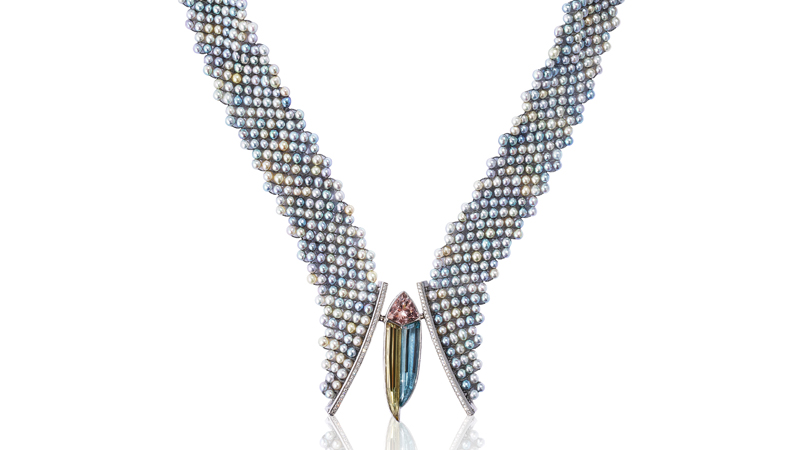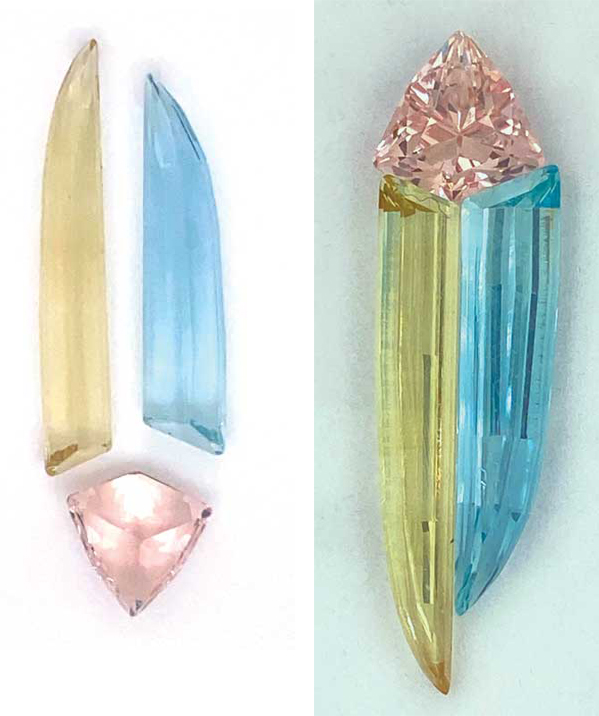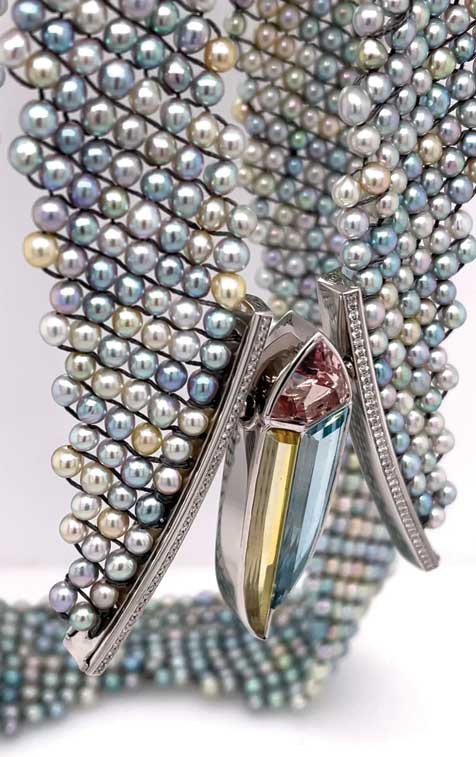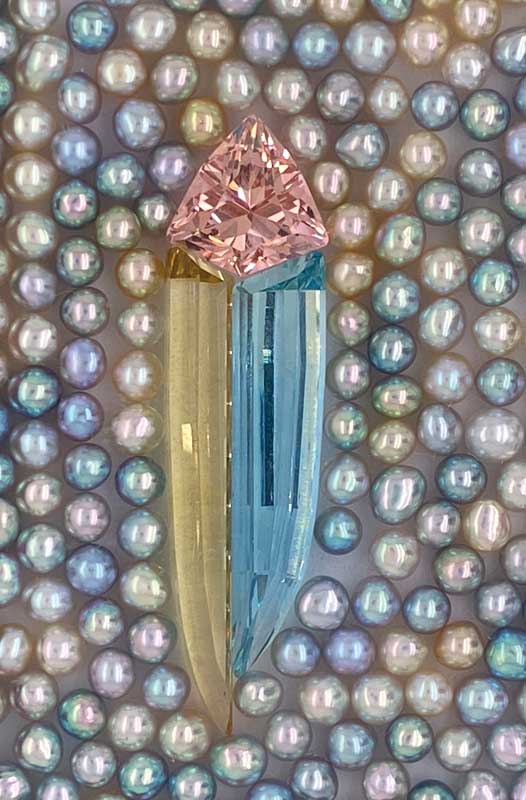A platinum dream, woven in pearls
March 7, 2022
“Oh, dream weaver,
I believe you can get me through the night.
Oh, dream weaver,
I believe we can reach the morning light.”
~ ‘Dream Weaver’ by Gary Wright (1975)

Llyn Strelau’s ‘Dreamweaver’ necklace (part of the Somewhere in the Rainbow Collection) won ‘Best Use of Platinum and Colour’ in the American Gem Trade Association (AGTA) Spectrum Awards competition.
Photo courtesy AGTA
By Llyn Strelau
"For this designer and bench jeweller, ‘Dreamweaver’ is the saga of the genesis and evolution of a jewellery design; the result of a collaboration between a team of talented craftspeople. Together, we captured the beauty of nature augmented by artistic creativity, serendipity, technical skill, and passion.

Stephen Avery’s ‘Dreamer’ suite (unset).
Photos courtesy Llyn Strelau/Jewels by Design
The ‘dream’ began three years ago at the Tucson Gem Fair. Stephen Avery, my great friend and one of the most creative and technically talented gem-cutters I have ever known, showed me one of his latest creations. The piece was one of his signature colour combos: a pastel three-stone suite of beryl—morganite, aquamarine, and heliodor.
Stephen has a keen eye for choosing exactly the right colour, shade, and intensity of gems. The resulting combination is always far greater than the sum of the parts. He dubbed his new cutting style ‘Dreamer,’ inspired by the floating feathers suspended from the indigenous dreamcatcher symbol.
My greatest appreciation for Stephen’s gems is that, while they are perfectly beautiful in their own right, he always leaves space for the jewellery designer to be inspired. Rather than simply framing the stones, a designer can use his gem as a springboard for an entirely new entity, taking the collaboration to even greater heights.
I immediately laid claim to the gem suite, already starting to sketch the jewellery possibilities.
Synchronicity kicked in next while visiting one of my favourite pearl dealers, Anil Maloo of Baggins. He showed me a bag with more than 2000 tiny (2.5- to 3-mm) multi-colour pastel Vietnamese Akoya pearls (with incredible lustre, to boot). The moment I put the beryl Dreamer suite next to them, the resultant heterodyne effect of the compatible colours was clear. It was magnificent; they were simply meant to be together! Of course, there was one small hurdle to overcome: the pearls had not been drilled. Fortunately, I was saved the task, as Anil offered to include drilling the pearls as part of the deal.
Vietnamese farmers cultivate Akoya pearls using Pinctada chemnitzii (the local equivalent of the Japanese species, Pinctada martensii), which have been raised in pearl hatcheries in the locale since 2001. Rather than bleaching and tinting pearls to obtain consistent shades, these farmers have, happily, kept their natural colours: sky blue, silver-blue, golden, and cream.
I carried the bag of pearls and my Dreamer suite around while browsing the Gem Fair and visited with long-time colleagues and friends. When I showed my finds to Shelly Sergent, the curator of ‘Somewhere in the Rainbow: A Modern Gem & Jewelry Collection (SITR),’ she was even more excited about the potential than I was. After sharing the gems with the owners of SITR, they agreed to purchase them with the proviso that, once I had completed the piece of jewellery, it would become part of the SITR Collection, and we could enter it in the American Gem Trade Association (AGTA) Spectrum Awards competition.
A plan in motion
My first decision: the design would be a neckpiece.
I pondered how to make the connection between the coloured gems and the tiny pearls. A twisted rope or torsade-style of necklace would be too bulky for the delicate Dreamer suite. I envisioned, instead, a woven web of the small pearls, but realized I had no concept of how this would be achieved.
An online search revealed many techniques for bead weaving and stringing. I purchased a bead loom and did a sample piece, but found the result to be too static and regular for the application. Further research led me to a style of hand-weaving called ‘peyote stitch,’ which is used by indigenous peoples to weave bracelets, neckwear, and other ornaments. With this technique, the pearls would be strung together one by one. A variation called ‘diagonal peyote stitch’ looked like the perfect solution—one which would give a sense of direction and movement to the weaving.

Dreamweaver’s pearls were handwoven by Strelau using a diagonal peyote stitch.
I decided the gemstones should be set in platinum. The metal itself would provide excellent security, while its neutral and very white colour would take a back seat to the delicate hues of the beryls. I wanted minimal (if any) metal separating the three gems to allow their colours to play off of each other to best effect, which meant refined platinum bezels with solid galleries beneath for support.
Additionally, I wished to utilize the bayonet findings system to add versatility to the design. Created and crafted in Germany, this ‘plug-and-play’ system (which I have dubbed the ‘interCHANGE’ collection) has become a signature of my work.
Next, I utilized computer-aided design (CAD) to further refine the piece’s technical details. Working off 3D scans of the three gemstones permitted accurate modelling of the basic bezels and also allowed for the inclusion of the bayonet clasp system. After some experimentation with shapes, I decided on the connection of the woven pearl ribbon to the gem-set pendant/clasp. I designed slim arcs of metal finished with a fine edge of tiny pavé-set diamonds. These would each have a male bayonet to mate with the bezel-set beryls and provide a secure connection, while also retaining the delicacy of their interface and contrast with the pastel gem colours.
Connecting the pearls to the platinum arcs required further thought and modification. I needed to find a method that would hide the connection, while also allowing for removal/reattachment should the pearl weaving require adjustments or repairs down the line. To achieve this, the main platinum pieces were made hollow. A separate component with drilled holes where the pearls would be connected would be fitted using a method-permitting removal without damage to any of the gems. This strategy would also expedite fabrication, as the goldsmith would be able to work on the gem setting while I worked on the pearl weaving and connections.
Teamwork prevails
The initial CAD models were milled in wax by my colleague Matthew Todhunter in Edmonton, then sent to Images Studio in Vancouver where Tony Loy cast them in a 950 platinum-iridium alloy.
A goldsmith colleague, Jerome McCann, took on the task of refining the rough castings to achieve the delicacy and finesse needed for the project. Separate bearings were hand-fabricated to support each gem and the completed bezels were connected with the bayonets tucked discreetly behind the junction of the morganite and other two gems. We achieved the goal of no visible metal between the aquamarine and heliodor while also framing the morganite.
My vision called for the woven ribbon of pearls to be approximately 30 to 50 mm wide. By its nature, the diagonal peyote stitch provides an angled termination. This would fit well with the arcs of platinum connected to the gemstones clasp.
Weaving the dream

The beryl suite matched perfectly with multi-colour pastel Vietnamese Akoya pearls.
Determined to do the pearl weaving myself, I had to find needles and beading cord suited for the task. Initially, the dealer had drilled the holes at 0.5 mm, but, after some searching, I had to ask for them to be drilled larger (0.6 mm). Peyote stitch requires the needle and thread to pass through a single bead more than one time—hence, the larger holes.
I was able to obtain very tiny needles and used a synthetic woven cord (actually a type of thread used by fly fishermen!). The woven cord is very strong, but also extremely smooth and flexible. It proved perfect, since I knew I would need to splice additional lengths of cord as I proceeded with weaving. After tying a connection knot, I could use a special tool with a heated tip to fuse the knot ends to ensure a secure joining.
While initially confusing for me, peyote stitch became a bit easier as I got further along. Eventually, it became almost like a type of ‘therapy’ (perhaps I will end up weaving baskets in my dotage!). Indeed, it was a very satisfying activity as the ribbon increased in length, pearl after pearl. I had a bit of a hiccup when I discovered the diagonal pattern could not be reversed at the half-way point (the front terminations needed to be mirror images). To solve this, I wove a second copy of the first ribbon and then used more pearls and creative stitching to connect them.
Coming together
Finally, three years after finding the pearls and gemstones in Tucson, the moment of truth came! The beryls were securely set in their bezels and the springs inserted in the bayonet, completing the interCHANGE pendant/clasp. Using a sewing technique, I attached the two ends of the woven pearl ribbon to the platinum bars, which were then mechanically secured in the diamond-paved arcs.
To wear ‘Dreamweaver,’ the male bayonets on the platinum arcs are pushed into the female findings in the gem-set centre piece with gentle pressure against the internal springs. A slight rotation while maintaining this pressure and release locks them together. There is still some flexibility of the connection, which allows for it to adjust smoothly to the wearer’s neck.
The beauty of using the bayonet clasp system is that the main, gem-set component can be worn on alternative chains or pearl strands, and, potentially, the woven pearl neckpiece could also have a different centre piece.
The final step on the Dreamweaver journey was to pack up the piece and send it to the AGTA Spectrum Awards. I crafted a satin-lined fitted case, which would allow the piece to be safely and securely held for transit and storage.
Then the waiting began! ... "
https://www.jewellerybusiness.com/bench ... in-pearls/